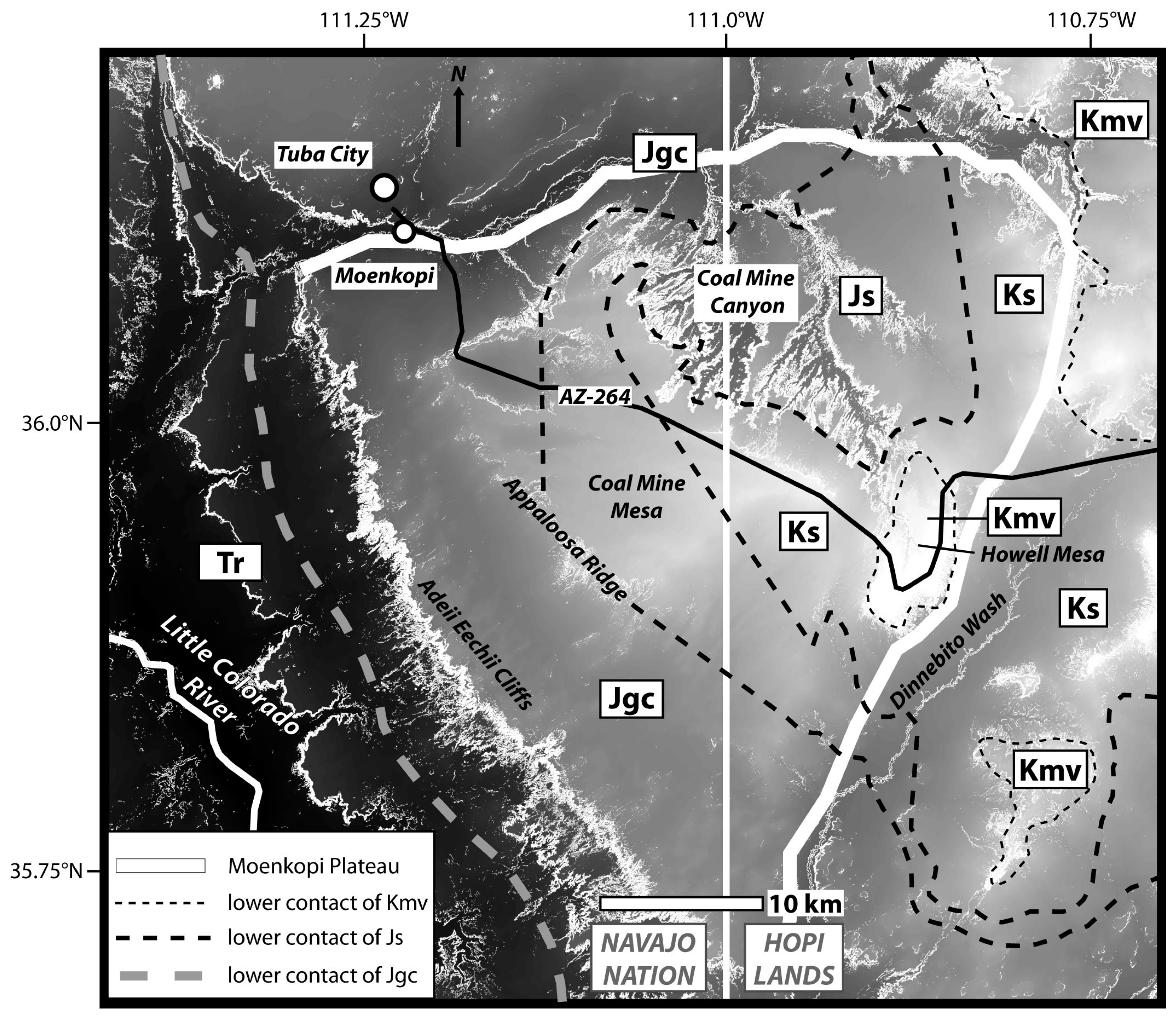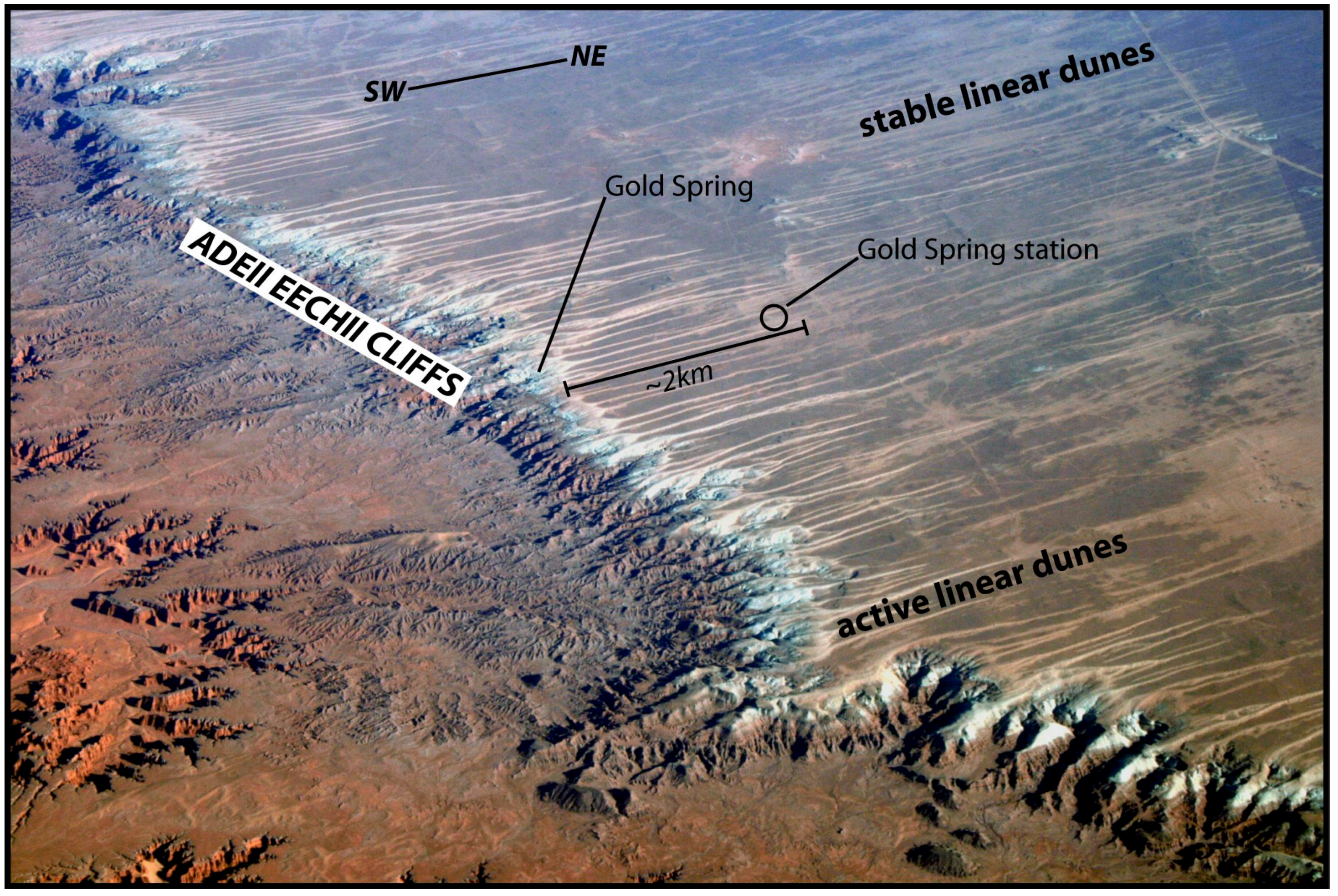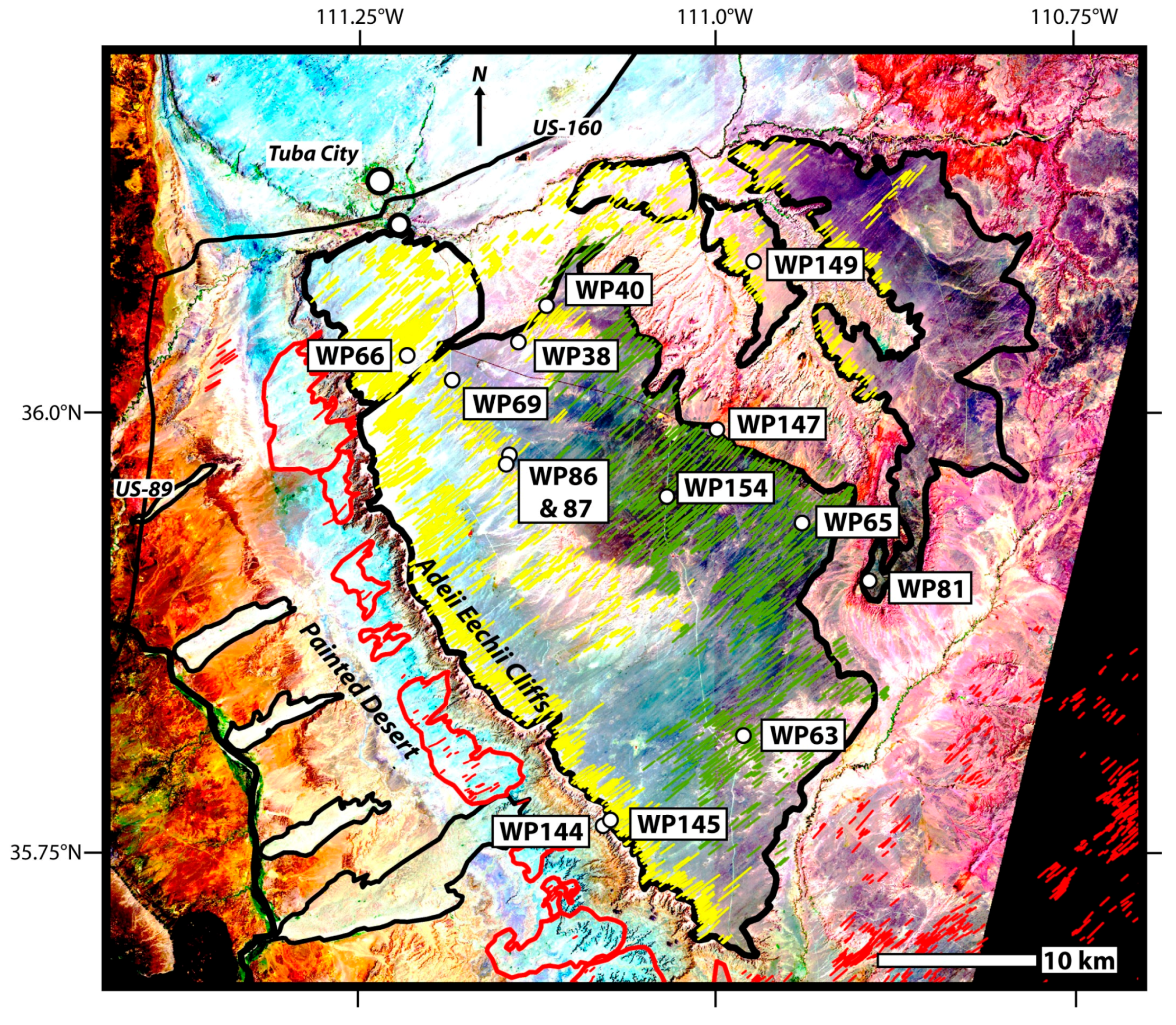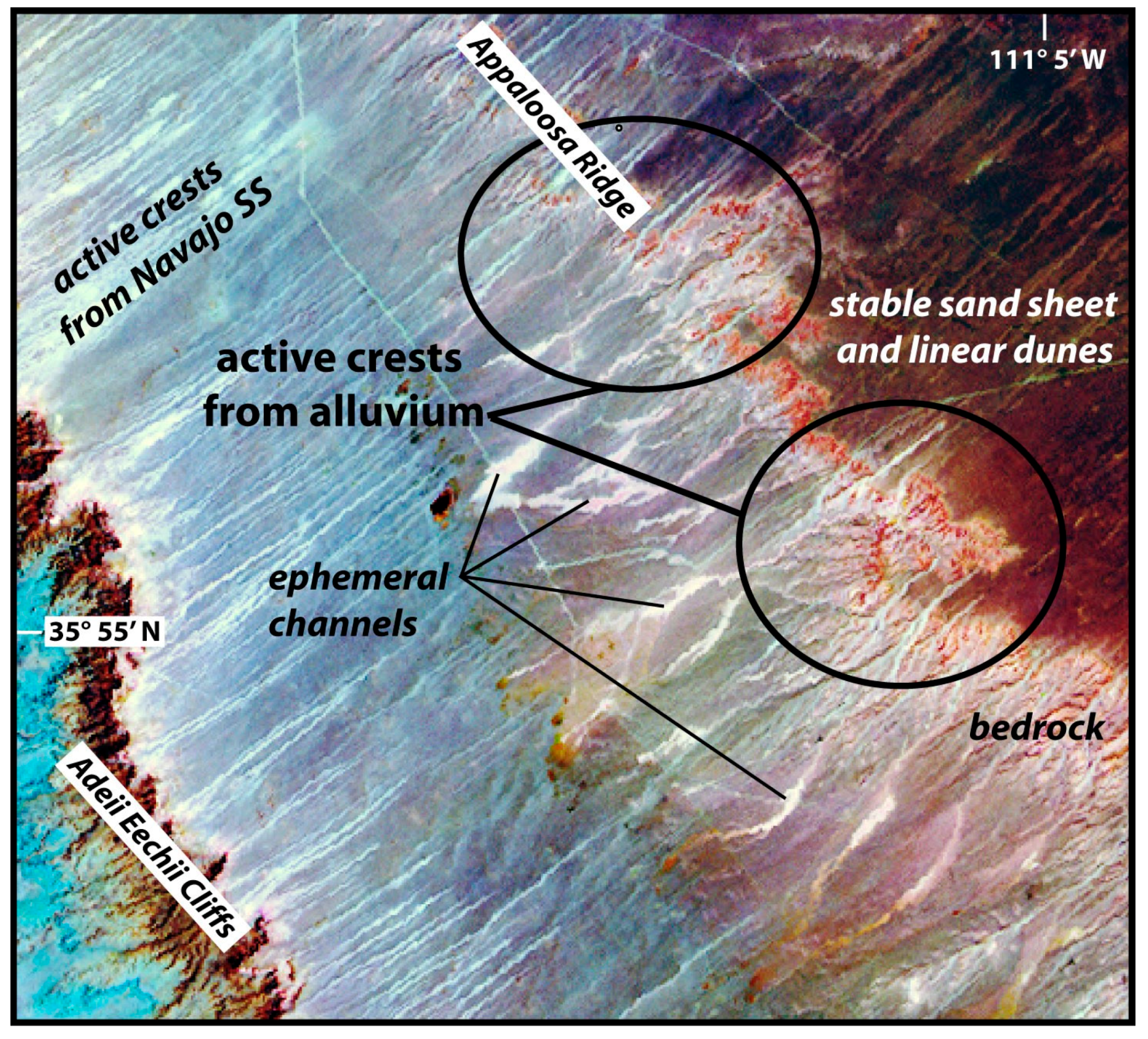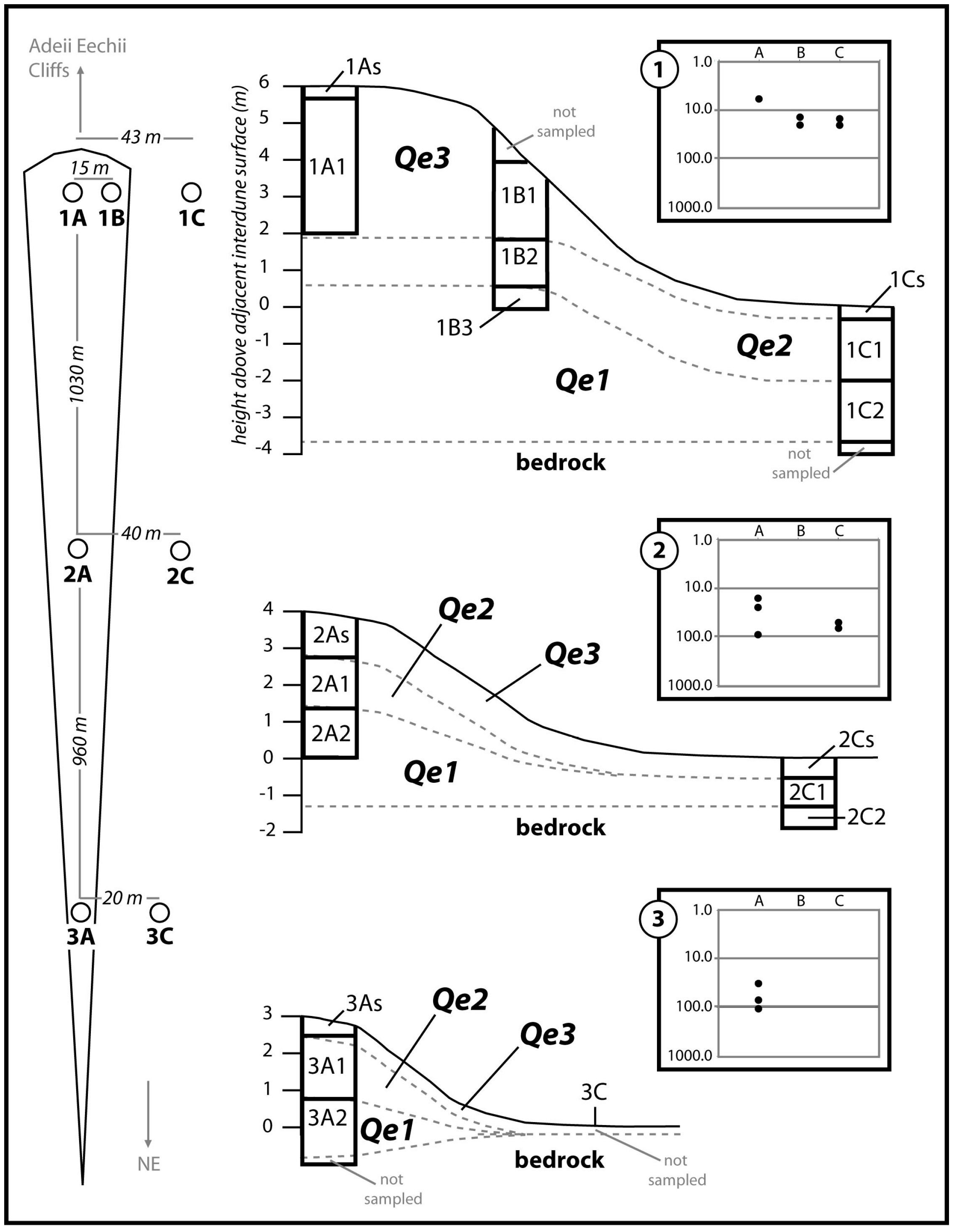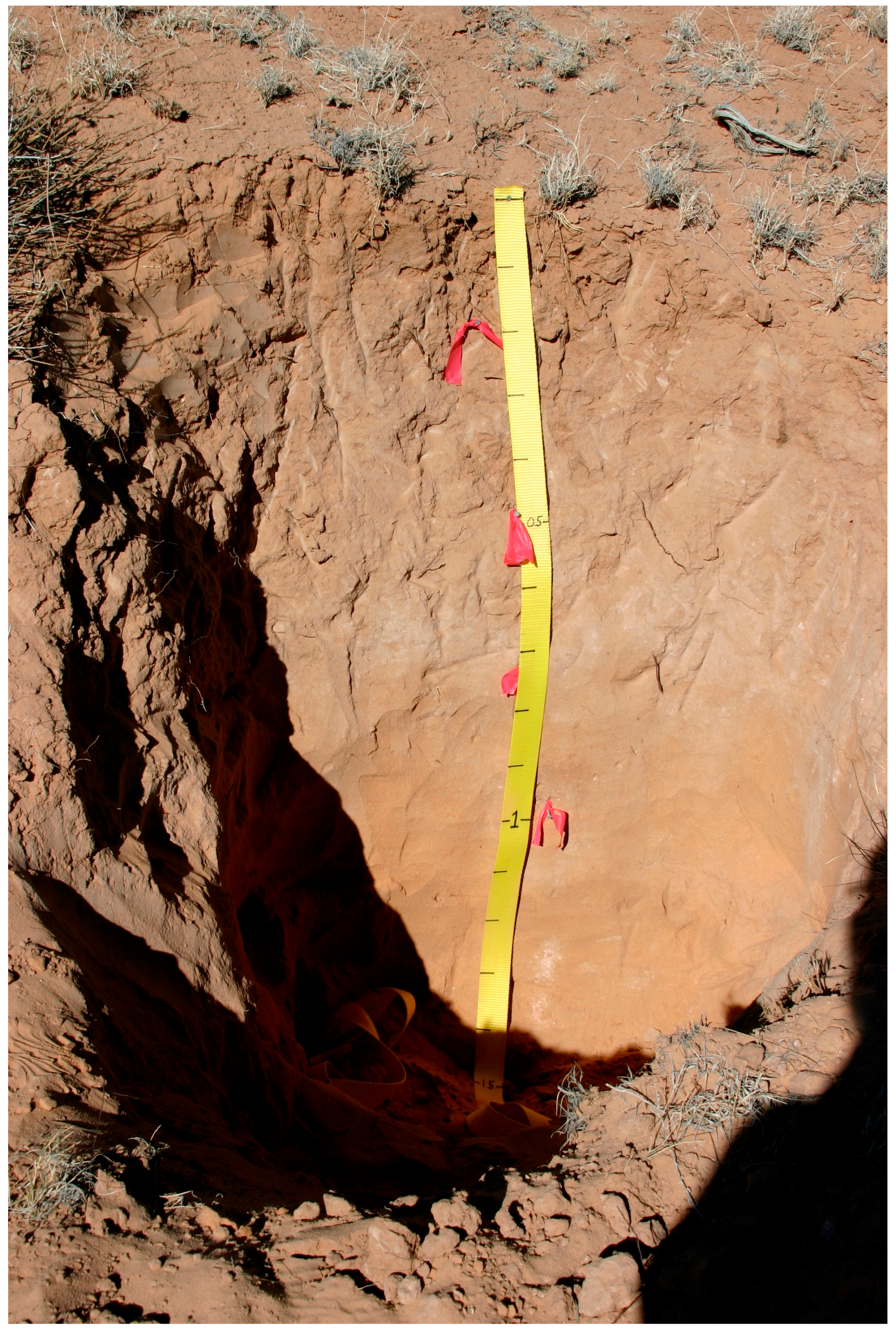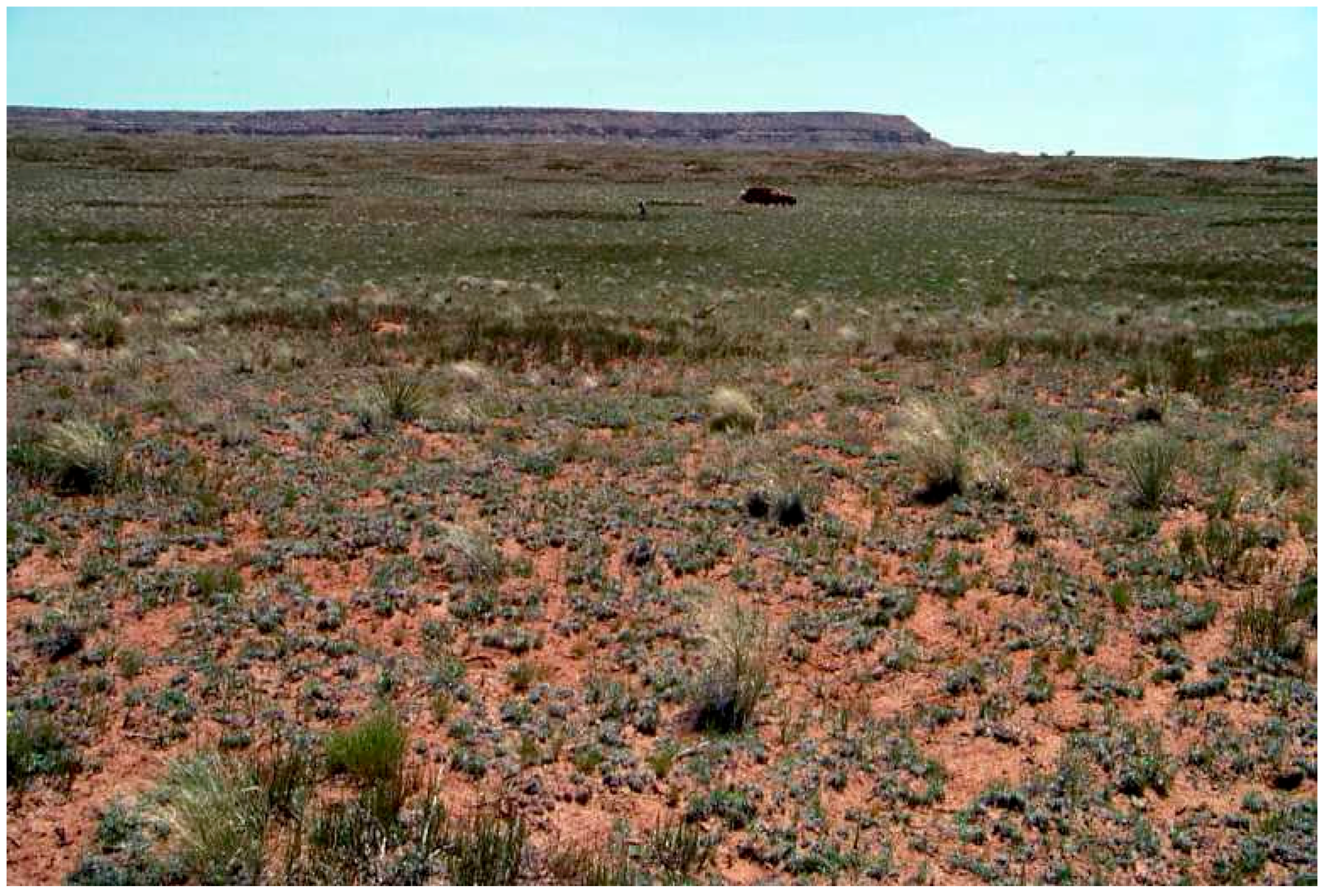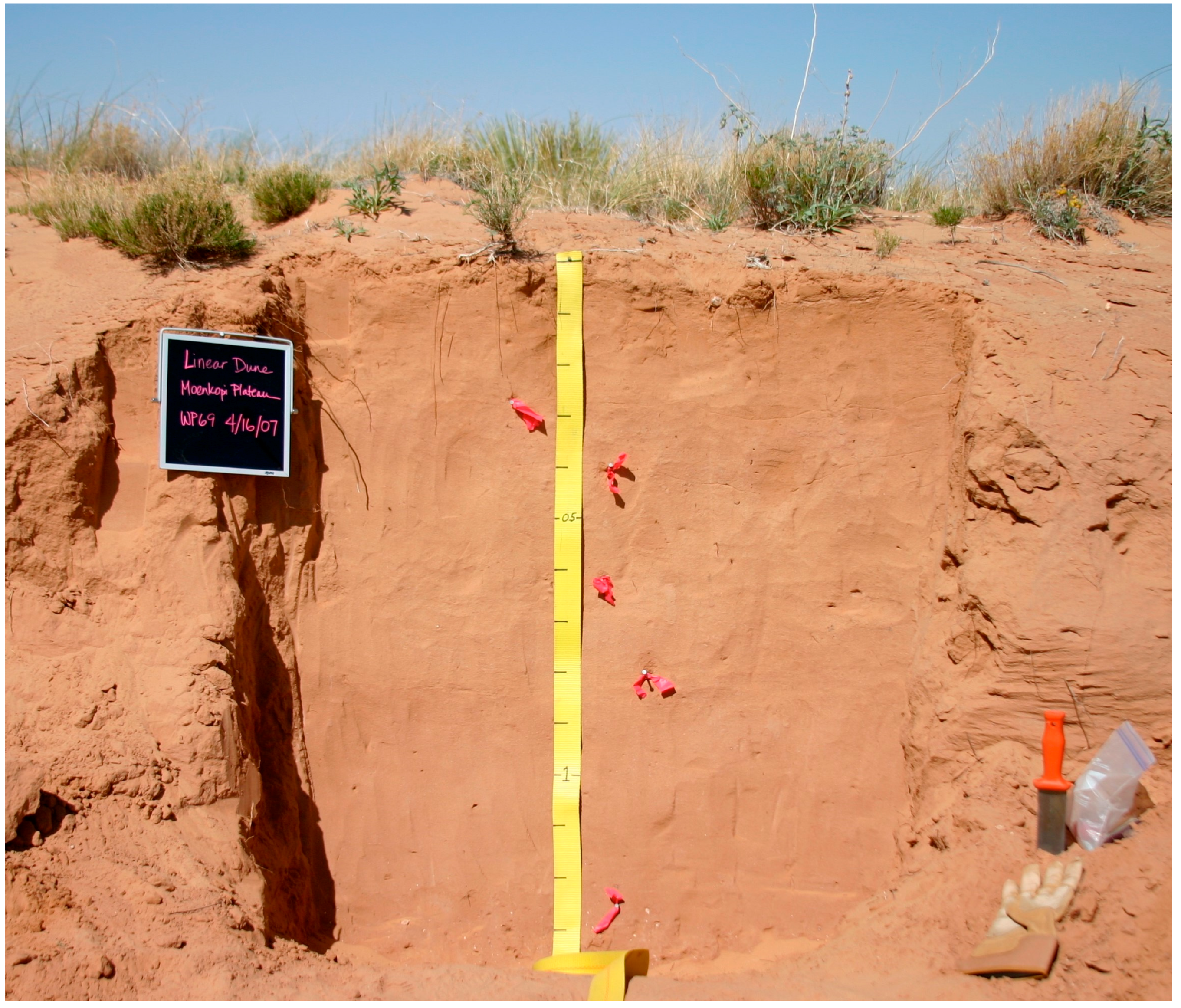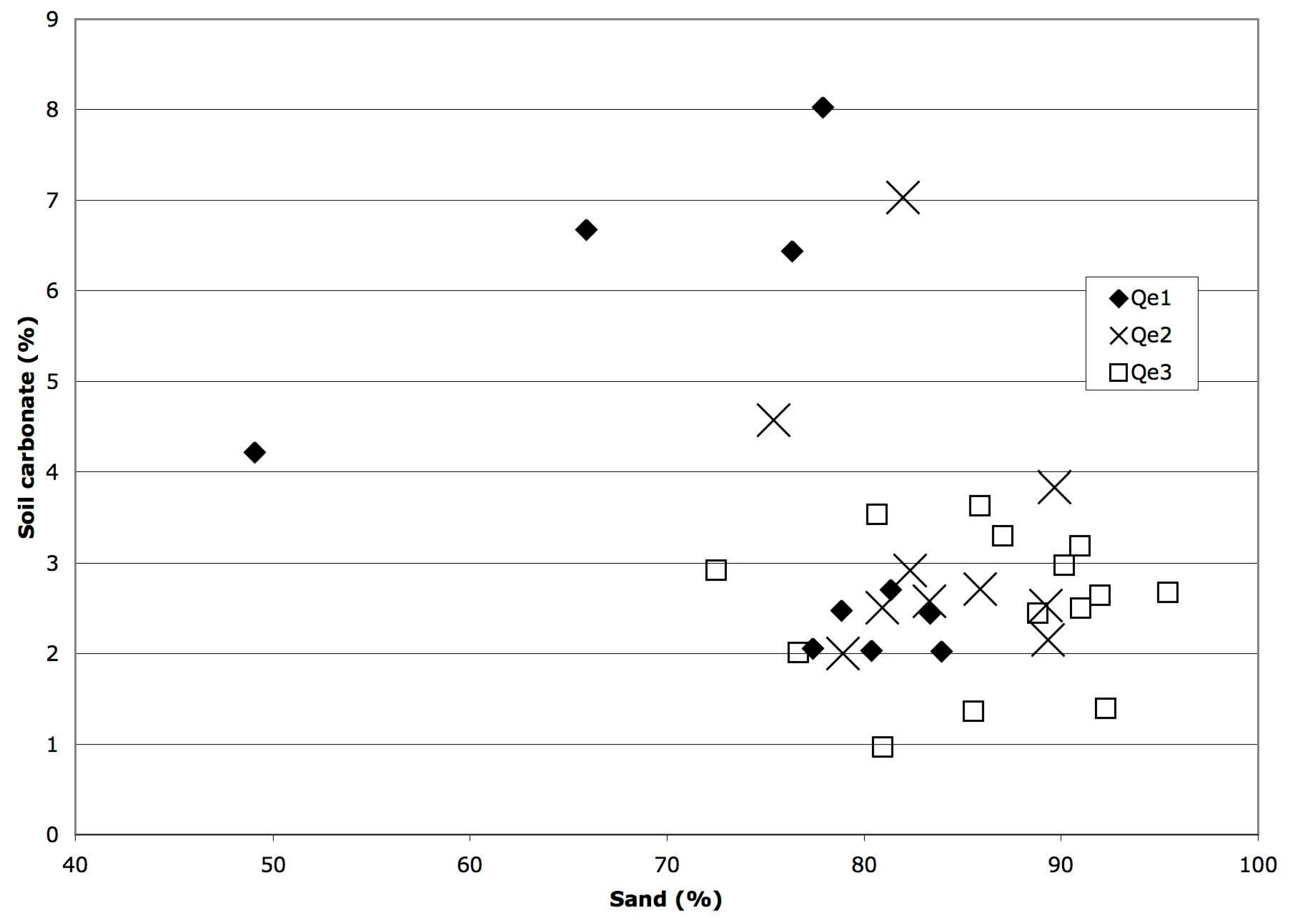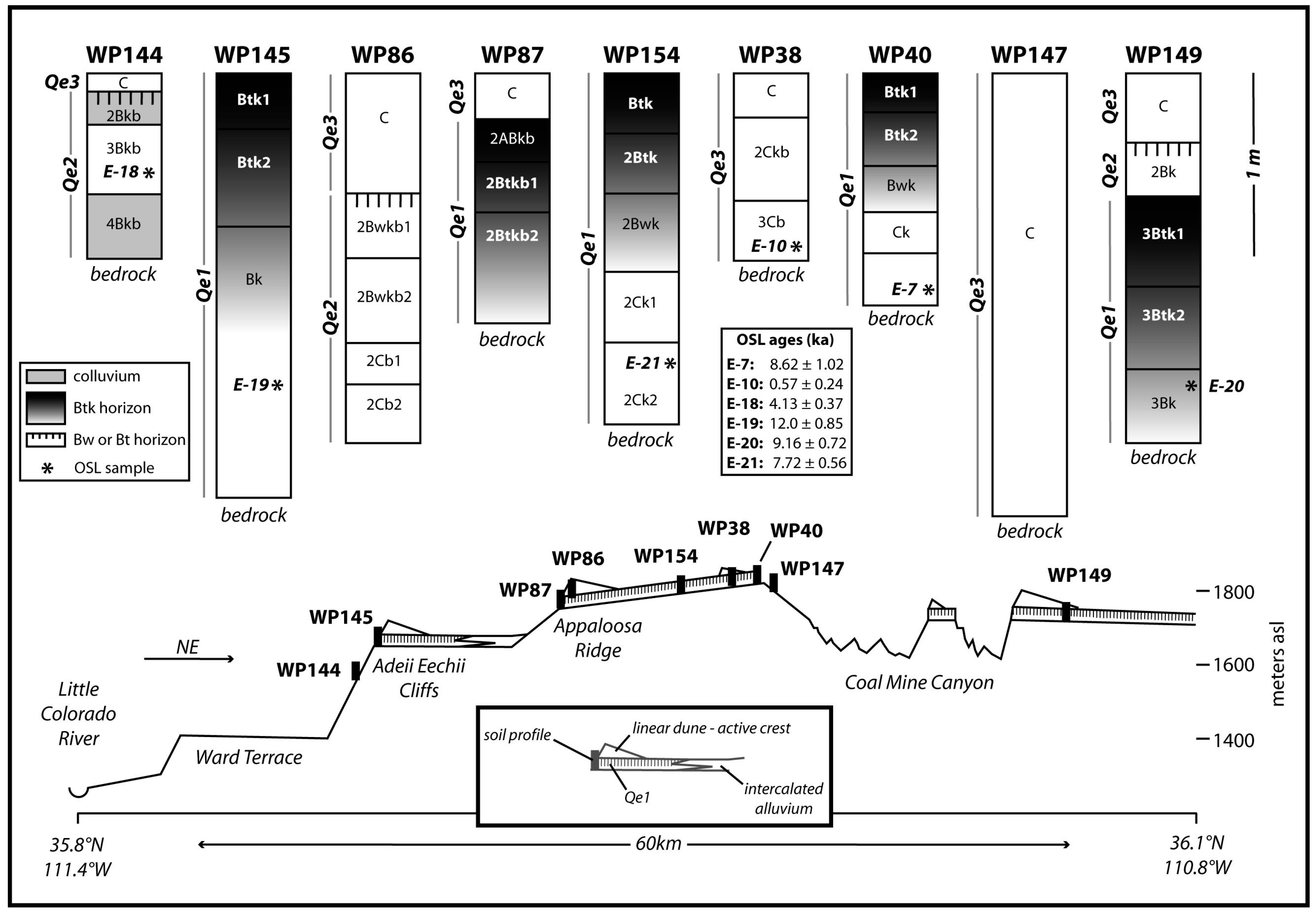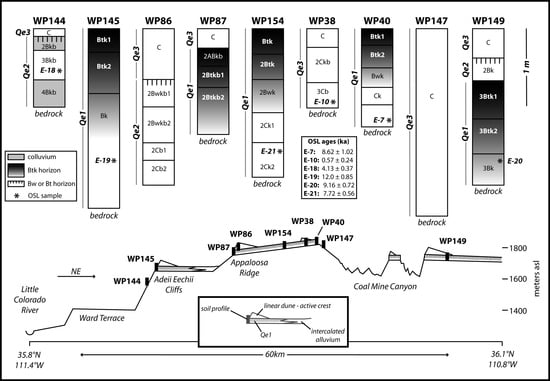4.1. Geomorphic Mapping: Aeolian Deposits and Sources
Upwind (southwest) of the Moenkopi Plateau, on the lower, more arid landscapes of the Painted Desert, linear dunes are uncommon and two major, dominantly active, aeolian map units were identified based on spectral response. Floodplain-adjacent dunes consist of thin sand sheets adjacent to local channels (
Figure 4, polygons bordered by thin black lines). These sand sheets locally contain a wide variety of active aeolian landforms, such as barchan and parabolic dunes, small climbing and falling dunes, and complex dune forms that exhibit characteristics of more than one aeolian landform. Landsat imagery is particularly useful for mapping these floodplain-adjacent aeolian landforms because of their high spectral contrast with bedrock, suggesting that the source for these dunes is floodplain sediments of the Little Colorado River and its tributaries, not local bedrock. Where examined in the field, most floodplain-adjacent deposits are thinly vegetated (visually estimated at <20% cover) and significant pedogenic modification was either very weak (e.g., few, faint, incipient carbonate filaments) or absent (no significant structural development and no evidence of pedogenic carbonate). The other mapped aeolian unit in this landscape position, bedrock-adjacent dunes (red polygons in
Figure 4), exhibits very little spectral contrast between bedrock and aeolian landforms; however, aeolian landforms are clearly identifiable in the 1 m DOQ mosaic. This unit is found exclusively within the section of the Jurassic Glen Canyon Group that contains the weakly cemented fine-grained aeolian sandstones of the Moenave Formation and the Wingate member of the Lukachukai Formation, which are dominantly composed of pale red to dark red or yellow quartz grains [
18]. Grain size and composition of the active bedrock-adjacent dunes are essentially the same as the local aeolian sandstones.
Linear dunes and sand sheets are the predominant dune forms in the study area covering most of the surface of the Moenkopi Plateau, especially on slopes <5–10°. Linear dunes with active, lightly vegetated crests are easily identified on DOQs and Landsat imagery as bright northeast-trending streaks (mapped as yellow lines in
Figure 4). Stabilized vegetated linear dunes and interdunes with moderate soil development (well-developed soil horizons with accumulations of pedogenic carbonate and translocated clay) appear much darker than active sparsely vegetated crests. Approximately 80% of Moenkopi Plateau aeolian deposits are stabilized; linear dunes with active crests are confined to areas immediately downwind of southwest facing escarpments (e.g., Adeii Eechii Cliffs and escarpments within the Coal Mine Canyon area) and the northwestern edge of the Moenkopi Plateau. Active linear dune crests are commonly 4–6 m above interdune area, whereas, in the stabilized parts of the study area, dune crests are typically only ~1–2 m high (green lines in
Figure 4). Image analysis shows that active linear dune crests along the Adeii Eechii Cliffs have similar spectral response to outcrops of the white Jurassic Navajo Sandstone positioned immediately upwind of active dune crests; active linear dune crests are also observed downwind from alluvial channels that drain bedrock slopes of Appaloosa Ridge towards the southwest (
Figure 5).
Our examination of the linear dune sediments near the Gold Springs meteorological station revealed that sand on the crest of the linear dune is very similar in grain size, sorting, and rounding to the Navajo Sandstone [
18], outcrops of which are heavily fluted along the Adeii Eechii Cliffs. Crest sand samples (1A) have the lowest magnetic susceptibility values, which are most similar to Navajo Sandstone (inset charts in
Figure 6), and do not contain the clear red quartz grains common in the other cored units (
Table 1). From the first transect to the third, surface crest samples become redder and magnetic susceptibility values and vegetation density increase with distance downwind from the Adeii Eechii Cliffs (
Table 2). In general, soil and sediment colors get redder with depth in all cores except the crest core at the head of the dune. Red quartz grains become more common both downwind and with depth in cores, suggesting mixing in the downwind direction and change in sediment source with depth. Field textural classifications show that active crest samples are classified as sand, but units below have increasing amounts of silt and clay. Effervescence and estimated carbonate stage increase with depth, as do magnetic susceptibility values, suggesting increasing concentrations of magnetic phases (e.g., hematite) presumably as dust is incorporated into older deposits that have undergone pedogenesis. The rate of change of described characteristics along the dune crest is much less than the rate of change from dune crest to interdune or the rate of change with increasing depth at any core site except 1A. In all cases, the oldest eolian sediments in the study area based on soil characteristics and OSL ages (see Qe1 below), contain fine, rounded, frosted, clear red quartz grains that based on petrographic analysis [
18] are likely derived from either the late Triassic- early Jurassic Wingate Formation or Moenave Formation sandstones and not from the Navajo Formation Sandstone. Well log analyses suggest that the combined alluvial and aeolian cover on the Moenkopi Plateau can be up to 10 m thick in places [
14], however, this pilot study indicates that aeolian sand along the Adeii Eechii escarpment is less than 4 m thick in the interdune position and thickest (6–10 m) along the linear dune crests. Alluvium was not observed at this site.
During field reconnaissance and site selection, we observed that almost all aeolian sediments on the Moenkopi Plateau had some component of the fine, rounded and frosted, clear red quartz grains shown to be derived from the aeolian sandstones located between the Little Colorado River and the Moenkopi Plateau [
18]. The only exceptions were sites in the most active linear dunes (e.g., the uppermost ~90 cm at WP38, the top ~240 cm at WP63, and the entire section at WP149). WP38 is located downwind of an active channel eroding Jurassic sandstones and WP63 is located immediately upwind of heavily fluted exposures of the Navajo Sandstone. WP149 is located along an escarpment of Coal Mine Canyon that exposes strongly fluted upper Jurassic sandstones and active but small climbing dunes. The latter dunes are observed upwind of linear dunes with active crests. Proximity suggests a very local source for sand at these locations.
Climbing dunes or sand ramps are not observed along the majority of the Adeii Eechii Cliffs, except as small, eroded remnants (e.g., WP144). One exception is a climbing dune that occurs near the northwestern end of the escarpment (where the red polygon adjoins the thick black polygon, southwest of WP66 in
Figure 4). Active sand (correlated to Qe3 below) immediately downwind of the ramp is spectrally similar to both the ramp and Moenave outcrops, suggesting a mainly local (immediately upwind) source for the sand composing the climbing dunes and the sand along the northwestern edge of the Moenkopi Plateau.
4.2. Aeolian Stratigraphy, Generalized Soil Characteristics, and Unit Ages
Extensive field reconnaissance led to identification of fourteen sites on the Moenkopi Plateau (
Figure 4) with characteristics representative of aeolian soil stratigraphy observed throughout the study area. Soil profiles were exposed and described at each site and dominant vegetation was identified and recorded (
Table 3). After extensive field work, dominant vegetation and vegetation density became useful in predicting the degree of soil development in underlying aeolian deposits before excavating soil pits. For example, vegetation density is highest on the stabilized dunes with the greatest soil development (the oldest deposits) and vegetation density is lowest, but biodiversity is highest, on active linear dune crests.
Soil profiles on the Moenkopi Plateau were grouped into three major units (Qe1, Qe2, and Qe3, from oldest to youngest) on the basis of patterns of soil and sediment characteristics, image analysis, vegetation type and density, and OSL dates. The related development of soil structure, consistence, and oriented clay films [
33] were particularly good indicators of the relative ages of aeolian deposits. Three aeolian units were defined using these criteria before OSL ages were obtained; those dates confirmed the original relative age ranking.
The most spatially and volumetrically extensive aeolian deposits on the Moenkopi Plateau exhibit the strongest soil development and oldest OSL ages. The unit associated with these deposits, Qe1, occurs as sand sheets with low relief linear dune crests mantling bedrock to an average thickness of 2–3 m. Six of fourteen representative soil profiles (WP40, 81, 87, 145, 149, 154;
Figure 7) show that this unit is generally characterized by stage II calcic horizons [
34] and weak to moderate argillic horizons based on soil morphology and particle size distribution (
Table 4) [
47]. Where the sandy parent material was not pedogenically modified throughout, the unmodified sediment colors range from yellowish red to brown (5YR to 7.5YR). Any original stratigraphy within deposits of unit Qe1, such as cross bedding, has been completely obliterated by subsequent pedogenesis and bioturbation. These stable aeolian landforms currently sustain a relatively dense
B. gracilis—
P. jamesii—
Ephedra spp.—
Yucca spp. community (~50–80% cover;
Figure 8;
Table 5), except where overlain by younger soil-stratigraphic units. OSL ages for the Qe1 soil stratigraphic unit range from ~12 to 7.5 ka (E-7, E-19, E-20, E-21;
Table 5).
Qe2 has only been observed as a buried soil in this study area and is therefore solely identified on the basis of soil attributes observed in exposures and excavations. Because Qe2 is not exposed at the surface, it is not identified from its associated biotic community, vegetation density, distinctive aeolian landforms or patterns in imagery. Qe2 is the least extensive unit observed in the study area, only slightly more pedogenically altered than the youngest unit (Qe3) and observed and described only in trenches that expose the interior of active linear dune crests or in uncommon blowouts. Seven soil pits expose Qe2 deposits (WP63, 65, 66, 69, 86, 144, 149;
Table 2) and are characterized by calcic horizons with stages that range from I− to I+ (Bk horizons) and B-horizon reddening (Bwk horizons). Qe2 is capped with weakly to pedogenically unmodified sand (Qe3, discussed below;
Figure 9) along linear dune crests and is therefore associated with the high-relief landforms and vegetation patterns characteristic of active linear dune crests of Qe3 age. Qe2 deposits yield OSL ages of ~4.2 to 3.5 ka (E-6, E-9, E-18;
Table 5).
The unit designated Qe3 includes the most recently deposited aeolian deposits associated with currently active aeolian landforms. Qe3 deposits occur in all landscape positions and are associated with the widest variety of aeolian landforms observed in the study area despite their relatively small volume. Qe3 exhibits the widest range in parent material colors from yellowish red, to brown, to yellowish brown (5YR, 7.5YR, 10YR), reflecting varied sediment sources, and either very weak color or soil carbonate stage development (incipient B horizon;
Figure 9) or show no discernable pedogenesis. As a result, subtle sedimentary structures, such as trough and low-angle cross bedding, are only observed and/or preserved in Qe3 deposits. Qe3 is usually expressed on the Moenkopi Plateau as active linear dune crests ~1–2 m thick over previously stabilized (Qe1 and/or Qe2) linear dune crests. Active linear dune crests are up to 6 m higher than the interdune elevation, thinly vegetated (<30%) landforms that support a variety of grasses (e.g.,
Muhlenbergia pungens,
Pleuraphis jamesii,
Oryzopsis hymenoides), sand-adapted perennials (e.g.,
Tripterocalyx cyclopterus,
Penstemon ambiguous,
Poliomintha incana), and a wide variety of annual herbaceous plants, though only dominant plants were recorded. Phytogenically induced accumulations of aeolian sand beneath canopies of
Ephedra sp. (coppice dunes) are common on linear dune flanks where crests are active. Though not described, field reconnaissance observations suggest that most aeolian landforms and deposits upwind from the Moenkopi Plateau, in The Painted Desert between the Little Colorado River and the Adeii Eechii Cliffs, cluster within unit Qe3. Three OSL ages (E-4, E-5, and E-10;
Table 5) show that sampled sediments with Qe3 characteristics are younger than 2.8 ka.
Aeolian transportation winnows and sorts sediments, and as such we might expect that the texture of original parent material comprising sand dunes would be well-sorted sand. Sustained soil development in a semiarid climate is characterized by substantial increases in clay, silt, and pedogenic carbonate. We observe these characteristic properties in our oldest deposits, Qe1. However, when we compare the ranges in these soil parameters from Qe1 to Qe2 and Qe3, we observe that the ranges overlap, rendering our units virtually indistinguishable using only soil texture and soil carbonate % (
Figure 10). As soil horizons and soil structure are relatively undeveloped in Qe2 and Qe3, we attribute the overlap in soil texture and carbonate values to deflation/erosion of soils of Qe1 subsequent to Qe1 soil development. Therefore, Qe2 and Qe3 parent materials may, in some cases, represent local erosion of Qe1 sediments, which are then redeposited a short distance downwind and restabilized.
4.3. Soil Properties Associated with Enhanced Cohesion of Sediments
In this study, all Qe1 profiles are characterized by Bt horizons defined by the presence of oriented clay films (argillans) that form as clay particles are colloidally translocated into the B horizon [
34]. Soil structure is typical of argillic horizons in Aridisols and is relatively advanced, when considering the parent material is well-sorted aeolian sand. Soil structural units (peds) are well developed with structural type ranging from angular blocky to prismatic (
Table 6). When exposed through trenching, peds are easily observable and when sampled, the mass is composed mostly of entire peds (
Figure 7). Oriented clay films were observed as bridges between or colloidal coatings on sand grains as well as lining soil structural boundaries (ped faces).
Dry consistence of Qe1 argillic horizons, evaluated in the field, ranges from slightly hard to very hard, with 75% of the argillic horizons ranked hard to very hard. Dry consistence is a measure of the “cohesion of soil particles to one another and the resistance of the soil mass to deformation” [
34]. Every Qe1 soil profile (except WP87) has at least one argillic horizon with hard consistence (see [
34] for definitions of soil morphological properties). At WP87, the maximum dry consistence was measured as slightly hard. The upper 0.5 m of the WP87 profile was notably moist at the time this profile was described in the field. Atmospheric humidity can strongly influence the erodibility of sediments [
48] and may account for the lower than expected cohesion in WP87 despite relatively strong soil structure (i.e., cohesion is likely strongest when the soil moisture decreases).
In contrast, 13 of 18 Qe3 soil horizons are classified as C horizons with very weak to weak aggregation (structural grade) and very easily deformable peds in a nonaggregated matrix (noncoherent to weakly coherent dry consistence;
Table 4;
Figure 9). Essentially, Qe3 aeolian deposits have been stable for so little time that they have undergone only incipient pedogenesis.
Qe2 soil profiles are only slightly better developed than Qe3 soils. The most well-developed Qe2 soil horizons do not exhibit oriented clay films, but do have reddened and/or carbonate-rich B horizons (Bwk and Bk, respectively), which are evidence for additions of translocated fines and soluble salts. Qe2 soil horizons are generally weakly aggregated (subangular blocky with barely observable peds and when disturbed for sampling, few peds are observed and much of the material is unaggregated) and weakly coherent (soft to slightly hard dry consistence). WP144 is the only Qe2 soil profile exhibiting horizons with greater coherence (hard dry consistence) and elevated soil carbonate (see horizon 3Bkb in
Table 4). This thin hillslope deposit is unusual in that it consists of intercalated aeolian and colluvial sediments (roughly 80% sand, 20% fines).
Boundaries between aeolian stratigraphic units are typically more sharply defined than boundaries between soil horizons within units (
Table 7). Boundaries within an aeolian unit are typically gradational between soil horizons; however, abrupt contacts within a unit can occur where a unit consists of more than one deposit. For example, the Qe3 unit identified at WP69 is composed of two distinct deposits (parent materials 1 and 2) separated by an abrupt boundary. Qe1 deposits commonly have abrupt upper boundaries in well-developed B horizons (Btk) and often those horizons are at the surface very thinly covered with active sand trapped by vegetation. The sharp upper contact of Qe1 and lack of buried A horizons in Qe1 suggests that the uppermost horizons of Qe1 have been eroded.

